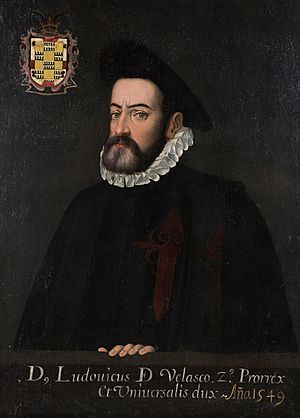Luis de Velasco, 2nd Viceroy of New Spain facts for kids
Quick facts for kids
Luis de Velasco
|
|
|---|---|
 |
|
| 2nd Viceroy of New Spain | |
| In office November 25, 1550 – July 31, 1564 |
|
| Monarch | Charles I of Spain |
| Preceded by | Antonio de Mendoza |
| Succeeded by | Francisco Ceinos |
| Personal details | |
| Born |
Luís de Velasco y Ruiz de Alarcón
c. 1511 Carrión de los Condes, Palencia, Spain |
| Died | July 31, 1564 (aged 52–53) Mexico City, Viceroyalty of New Spain |
Luis de Velasco y Ruiz de Alarcón (1511 – July 31, 1564) was an important leader in New Spain. He was the second viceroy, which means he was like a governor, for the Spanish colonies in the Americas. This was in the middle of the 1500s, when Spain was building its empire.
Contents
Life and Work of Luis de Velasco
Early Life and Career
Luis de Velasco was born in 1511 in a town called Carrión de los Condes, in Spain. His family was wealthy and important. He received a good education when he was young. By 1547, he had become a leader in Spain's army. He was also a viceroy in the Kingdom of Navarre.
Becoming Viceroy of New Spain
The King of Spain, Charles V, was impressed by Velasco. The King sent him to New Spain in 1550. New Spain was a large area that included much of North and Central America. Velasco's job was to fix problems there. These problems included slavery and a system called encomienda. This system forced native people to work for Spanish settlers.
Velasco traveled with his son, also named Luis de Velasco. His son would later become a viceroy too. Velasco took over from the first viceroy, Antonio de Mendoza. Mendoza chose to become the viceroy of Peru instead.
Velasco arrived in New Spain in August 1550. He officially became the Viceroy of New Spain on November 25, 1550. He served in this important role until he died in 1564.
Helping Native People
Velasco worked hard to protect the native people. He helped them against unfair gold mine owners. He also freed about 15,000 native people who had been forced into slavery.
He also started public services for native people. These included hospitals and law enforcement.
Education and New Towns
Velasco believed in education. On January 25, 1553, he opened the Royal and Pontifical University of Mexico. This was a very important step for learning in New Spain.
He also ordered the creation of new towns. Some of these towns include San Miguel el Grande (now San Miguel de Allende), Durango (founded in 1563), San Felipe de Ixtlahuaca, and Nombre de Dios.
Challenges and Later Years
In 1558, New Spain faced a big flood. After the flood, an illness spread. Velasco did his best to help everyone affected.
For many years, Velasco had a lot of power as viceroy. But around 1560, some powerful Spanish people tried to limit his authority. They wanted his actions to be approved by a group called the Audiencia.
In his last years, Velasco focused on new projects. He wanted to start settlements in Florida. He also wanted to explore the Pacific Ocean. He hoped to find more riches for the Spanish Empire.
In 1559, Velasco sent 13 ships to Florida. The goal was to build new settlements. But this trip did not go well. The settlers faced hunger and fought with native warriors. They had to leave the settlements.
In early 1564, Velasco planned another big trip. He sent Miguel López de Legazpi and Andrés de Urdaneta to cross the Pacific Ocean. They were going to the Spice Islands. These islands had been visited by explorers like Ferdinand Magellan before.
Luis de Velasco died in 1564. People found that he had not become rich while in office. Instead, he had gone into debt because he cared so much for the poor and the native people. After he died, Francisco Ceinos took over as a temporary viceroy.
See also
 In Spanish: Luis de Velasco y Ruiz de Alarcón para niños
In Spanish: Luis de Velasco y Ruiz de Alarcón para niños

